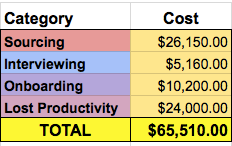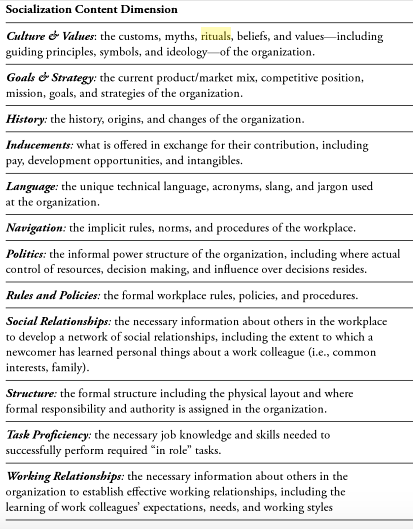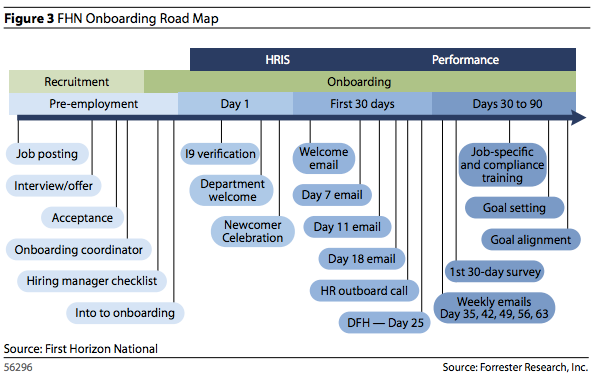Why Employee Onboarding is Holding Back Your Team, and How to Get it Right
Evergreen is a weekly collection of links to the best learning resources in business, collected by a group of managers, founders, and investors. We contribute resources about one topic each week, which are synthesized and shared in this Weekly Edition. The aim is to learn more efficiently through increased context and focus. Join here to receive the next Edition of Evergreen Business Weekly.
Remember, these are designed to feel like short books, you’re meant to meander and spend ~3 hours on this topic this week. Save some of these links and read them throughout the week. Immerse yourself in this topic and leave the week smarter than you started it!
A High-Leverage Way to Improve a team
Onboarding a new employee isn’t tremendously hard, but it is high-impact. Done well, it will decrease turn-over, improve team-work, and give employees a sense of belonging. Done exceptionally well, it can create a cult-like devotion to a company. This makes it one of the highest-leverage ways to increase the effectiveness of a team.
Here’s how we’ll take a look at Onboarding in this Edition of Evergreen:
- Why New Employee Onboarding is so damn important
- Why Onboarding is so easy to get wrong
- The most crucial things to get right
- Tips, Tactics and Tools
Every business is different, and seeks to build a unique culture. Whatever your current process is, it can be improved in some small way that will lead to enormous gains in culture and the bottom-line.
Why is Onboarding so Important?
The process of incorporating a new employee into the culture and progress of a company, as a whole, determines how effective they are going to be, and how long they’ll remain with the company. These two variables will determine the ROI of an employee’s total contribution — and better onboarding is a good way to improve both of these variables and therefore, improve the business.
How much does it cost to replace an employee?
Jason Evanish wrote a great post, Why replacing a good employee will cost you $65,510, that shows the basic math of the full costs of replacing an employee. Read his post for the full methodology and breakdown, but here is the essence of it in one glance:

Of course, your costs will vary, so do the math yourself using Jason’s framework. Be brutally honest with yourself and see what your costs are, including opportunity cost. Consider this sum the consequence of poor onboarding processes.
Thanks to Teddy Zetterlund for contributing this post. Good thought!
Avoid Making Employee Progress Impossible
It is not a given that adding more people to a team increases it’s productivity linearly, let alone gaining any incremental advantage. In some cases, adding employees actually decreases the productivity of the current team. This, as Kate Heddleston calls it in her post, is ‘Team Debt’. Team debt is similar to technical debt, defined as the “eventual consequences of poor system design.”
It’s the idea that when employees aren’t properly trained, integrated, or managed, they are operating at less than optimal efficiency and “team debt” is accrued. Each new employee that is added without being sufficiently trained and integrated increases that debt. If unchecked, team debt can reach a point where expansion must be halted in order to address the deficiencies of the existing system.
Some examples of deficiencies: new employees being unable to navigate in the organization, or unaware of protocols or company guidelines. A good onboarding process can reduce “Team Debt” and ensure that new employees are additive rather than subtractive.

Onboarding and the Cost of Team Debt is an excellent post full of good ideas and thought-provoking questions. Thanks to Jason Evanish for recommending it!
Onboarding as a Competitive Advantage
For most businesses, the earnings are based on the quality of the work produced by employees. In order to dominate your competition and grow, you must attract and retain the best employees possible.
“You need to weaponize your HR process.”
This is the focus of this post on First Round Review, Employee Onboarding at Startups is Broken — Here’s how to Fix it. A fantastic post full of observations about the role of Onboarding in the business, as well as specific tactics to employ. Don’t lose sight of that fact that employees don’t begin their first day bought in 100%… you have to keep selling!
To really optimize someone’s first experience with their work environment, you need to be thoughtful about how to improve the onboarding process and provide hospitality,” says Guthrie. “First days are an opportunity to tell the story of who you are and what you want to accomplish, and have that stick with every single person who joins your organization. You want to take the opportunity to validate their decision to join.
Don’t ever believe that you’re ‘too busy’ to make a good experience a priority for a new employee. This is your defense against poachers:
If you accept the fact that people are too busy to give new employees a good experience, that attitude will perpetuate every time you bring someone new on.
You say you’re too busy. You work at a tiny startup after all. But that’s no excuse, Guthrie says. “You’re not too busy. You just spent all this time, energy and money getting this new person to join. Blowing it is going to cost you even more when you have to start the hiring process again from scratch. Don’t make someone feel like you’re too busy to make them feel good about choosing to work with your company.
Your goal should always be to make people believe on a gut level that your organization is so amazing that they couldn’t possibly work anywhere else. Building that attitude starts immediately once an offer letter is signed. And if you do it right, when the phone rings and it’s a recruiter on the end of the line offering the next big thing, they’ll say, “Sorry, I’m happy where I am.”
As usual, this post from First Round Review is fantastic and very worth checking out. Thanks to Karsten Thomann for the contribution!
An easy thing to get right (or Wrong)
New Employee Onboarding is an easy thing to get right. It’s not overly complicated or difficult. There isn’t any magic formula that evades us. However, it’s also easy to do wrong— why is that?
- Onboarding isn’t an extremely-common occurrence in most businesses (except for huge or high-turnover companies), so it doesn’t tend to be as perfected of a process as those that are done weekly or daily.
- It rarely receives good feedback, as it’s victims are new to the team and unwilling to criticize their new employer on the first day. So visibility into the process is low.
- Often, the responsibility of onboarding is spread across multiple people. Distributed ownership leads to confusion and poor organization.
- Consequences of poor onboarding practices are non-obvious and often delayed until months or years later, when it’s harder to connect to onboarding as the cause.
- Onboarding is difficult to parse out as a causal factor for a failure in personnel. Often the hiring decision is blamed, or is conflated with other factors such as management, culture fit, etc.
Understanding these factors as contributors to the opacity of the onboarding process, you can set up countermeasures to work through them and ensure that the process is evaluated and improved.
How to get Onboarding Right
Which pieces of this process are most important to nail in order to get employees settled in happily and working quickly? Let’s look at the most important pieces of the onboarding process…
Full List of Stuff to Address through Onboarding
There are quite a few lists out there that purport to catalog the different things that new hires need to learn to be an independently-functioning agent within the organization. The most complete list that I found was from The Oxford Handbook of Organizational Socialization:

This list is perfectly thorough — it’s amazing how much new hires are expected to learn that seasoned employees take for granted. Does your process account for the newbie learning everything on this list? Are you empathetic of the enormous amount of information that new hires are expected to learn in a short period of time?
Take the broad view of the Onboarding Process
Want to cut your voluntary turnover rate by nearly 50%? You can follow the process laid out by First Horizon National in 2008, and broaden the scope of employee onboarding.
This case study shows the strategic need, the execution, and the results of their onboarding process changes. When they started viewing this as a 6–9 month process, “overall voluntary turnover rate shows a decline from 19.5% in 2008 to 10.96% at the end of 2009.”

One of the best lessons we can take from this is that they take the broadest possible view, looking at the process as beginning the moment of offer acceptance, and extending through nearly the first year of employment.
How Medallia Reprograms it’s New Hire’s Brains
Some Onboarding processes go far beyond educational and into transformational. Medallia claims a ‘life-changing’ experience for it’s employee’s first week on the job. Medallia invests deeply in it’s onboarding process — 9,360+ working hours, in fact.
Founder Amy Pressman talks about how this process changes people and deeply reinforces the values they prize in their company. Check out the first few minutes of this video: (can’t embed video because TC is greedy for traffic)
Pressman reveals a few strengths of their Onboarding process in just a few sentences:
- The Kindle + Fitbit gifts suggest that they’re wholistic, they encourage growth and improvement in all areas.
- They take NPS Scores on their onboarding process to get feedback.
- Medallia teaches various new subjects, like design thinking. This investment in them early on is a meaningful signal to new employees.
Thanks to Matt Frost for suggesting Medallia as an example of excellence in onboarding.
Tips, Tactics and Tools for Onboarding
So who else is doing it right? Here are the great ideas that we can borrow for our own companies — if you find more or know of some that aren’t listed, just comment with them here!
Create a Document with schedules, to-dos, & FAQs
This lovely little piece of content marketing from Trello called Onboarding New Hires with Trello, does a great job of breaking down what they found was important to include in their process, from office questions to first day to-dos. This is great because of the repeatability of it, for those hiring rapidfire.
If you haven’t read The Checklist Manifesto, it’s a fantastic book and will prove to be a helpful tool for building this system. Onboarding is a challenge perfect for a Checklist solution — repeatable, standard, and multi-faceted. This book is a quick read that will take your checklisting to the next level.
Thanks to Matt Donovan for suggesting the post from Trello. He’s used that template to success in our onboarding efforts at Zaarly.
How is Whole Foods like the show ‘Survivor’?
Whole Foods has a genius mechanism where, 90 days after a new hire has started, their peers get to anonymously ‘vote them off the island’, or basically fire them. This is a great system because it gives the team the ultimate veto power (if it is in consensus), without taking a ton of time and requiring snap judgements with minimal information in the hiring process.
This knowledge changes the onboarding process, and incentivizes friendly interactions amongst the team. This was fascinating to me, and I wonder how many other companies have ‘peer-review’ systems with as much power.
Use the Buddy System
One common (and empirically useful) tactic is to use the buddy system. Many challenges for new hires are questions that anyone can answer, but people hesistate to pester their manager for. Buddies can be great for all the little things, lunch dates, and company history. Having someone designated to ask is a small but significant way to lower the barrier of access to the organization.
Percolate has a good onboarding system going, based on the buddy system. Also, I know it has worked well for my friends over at Anyperk.
Thanks to Jason Evanish for the link to Percolate, and Aaron Wolfson for suggesting the buddy system.
Geek Squad’s Branding isn’t just for Customers
If you think that the Geek Squad is dressing up in it’s classic skinny ties just for the customers, you’re not seeing the full picture. Robert Stephens, founder of Geek Squad, fully understands the power of belonging. He knows that the uniform conveys a sense of being on a team together.
Here’s a quote from Stephens from a Fast Company Article, 1999.
Employees are growing more savvy about what companies they work for. […] You have to market to your employees, so one thing I have been telling people is that a lot of the image is not just for the business — it’s also to market to the employees, to attract the best people.
The success of that is evidenced by our really low turnover rate. My people get job offers from other companies and they stay because they get the badge and the Geekmobile. They like knowing that the company they work for is different.
A part of that is the secret ritual onboarding process that Geek Squad agents conduct for each other — it’s another mechanism of creating belonging — and it works. It’s employees are (or were, before the Best Buy Acquisition) massively dedicated to the company, and to their fellow Geeks.
Here’s proof:

Open Questions
For the curious who want to keep pondering this process and see how much improvement they can squeeze out of it…
- What tasks can be completed by new hires on their first day to get a ‘win’ on the board?
- How can you socialize new members as quickly as possible with a broad selection of the company?
- What traits do you want in your employees that can be ‘programmed’ in by onboarding experiences? How?
- How can you create initiation rituals that reinforce a sense of team-work and belonging?
- What are truly the first and last steps of your onboarding process?
- Are you able to personalize the process based on the employee’s personality to ensure a good fit?
Take these new ideas and challenges and get to it — see you out there.
If you enjoyed this, you’ll get more like it by joining Evergreen:
My Other Projects
Upcoming Book: The Almanack of Naval Ravikant
Evergreen Lives on Donations
Creating Evergreen takes a lot of time and decent amount of money. If you find anything helpful and interesting here, please consider buying me some BBQ ($11 Z-Man & Fries at Joe’s KC), or really anything between a coffee and a good dinner. Thank you very much! ❤ ☺
Thank you
Massive appreciation for all contributors to this Edition of Evergreen: Aaron Wolfson, Jason Evanish, Teddy Zetterlund, Matt Frost, Karsten Thomann, and Matt Donovan.
Many thanks for being a part of this project! Not every suggestion is able to make it to the final edit, but every single suggestion is read and appreciated.
Never Enough
As my Father always says: “There’s always room for the best.” There’s always a better resource out there. These collections can always get better, and I hope that they do. If you can think of anything that was missed, I welcome you to share it.
To share your thoughts, improvements or additions: Email or Twitter.
If you liked this, check out other Editions of Evergreen:
Building and Managing a Team:
How to Find and Recruit the Team you Need
How Not to Hire like a Clownshow
Compensation Rules Everything Around Me
Why Employee Onboarding is holding you back
How to Boost Employee Retention
How Performance Reviews are being Reinvented
Secrets to Perfecting Organizational Communication
How to Manage Scale, and Operate in Scaling Organizations
How to Fire an Employee
What you actually need to know about Company Culture
How to Interview Prospective Hires
Strategy and Competitive Advantage:
How to Master the Craft of Strategy
Competitive Advantage: How to Build a Winning Business
The Power of Network Effects
How Cost Leadership Builds Powerful Businesses
Why the Best Brands Stand Out
Scale as Competitive Advantage
Barriers to Entry are Confusing
Flywheel Effect: Meta-Competitive Advantage
Building the Business:
How to be a Great Human:
How to Start a New Job: Handling Career Transitions like a Boss
How to Master the Discipline of Product Management
The Ancient Origins of Storytelling, and how to Apply Them
I've also written about How & Why we started Evergreen:
How a prototype's failure created the next iteration
Mission & Method of Evergreen
Follow me on Twitter: @EricJorgenson
And Please... Join Evergreen.


